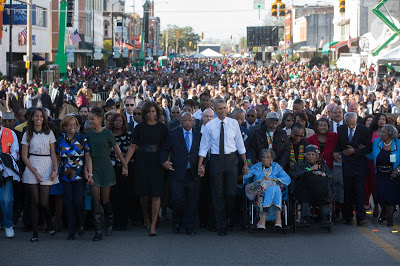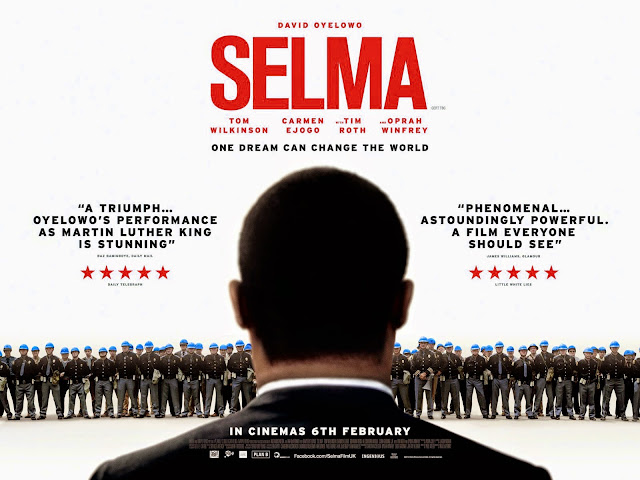This year's Selma bridge crossing march featuring Vice President Kamala Harris was held Sunday, March 3. Selma now largely embraces the event and promotes it as a major tourist destination.
They are calling this year’s commemoration The Selma Bridge Crossing Jubilee which will mark the 59th anniversary of Bloody Sunday—the day on March 7, 1965, that Civil Rights marchers were brutally beaten by law enforcement officers on Selma’s Edmund Pettus Bridge which has stretched into a nearly week-long event. Since the anniversary fell inconveniently mid-week, the recreation of the march across the bridge was held on Sunday March 3. Vice President Kamala Harris was an honored participant and made international headlines with her sharply critical remarks on the relentless Israeli attacks with civilian casualties, dislocation, and famine and a call for a ceasefire. Falling short of withdrawing U.S. support for the Israeli war machine, the remarks were none-the-less not as out of context at an event protesting American apartheid than it might first seem.
March 7, 1965 was Bloody Sunday in Selma, Alabama. On that day massed Alabama State Police attacked peaceful demonstrators attempting to cross the Edmund Pettus Bridge on a march from Selma to the state capital at Montgomery to protest suppression of voting rights.
Alabama State Police beat SNCC march leader John Lewis, on ground center, after charging voting rights marchers trying to cross Edmund Pettus Bridge from Selma on the way to the state capitol in Montgomery in 1965.
Members of the Student Non-violent Coordinating Committee (SNCC) had been conducting voter registration drives in the area since 1963 and had encountered escalating violence. After the passage of the Civil Rights Act of 1964, efforts stepped up. On July 6 of that year SNCC leader John Lewis attempted to lead a march on the county court house to register voters. He and other marchers were beaten and arrested. A few days later a local judge handed down a sweeping injunction against more than two people assembling to even talk about voter registration.
Two SCLC organizers arrived to join the voter registration effort. Diane Nash like John Lewis was a veteran of the Nashville public accommodation sit-in campaign of 1960. Her husband, Rev. James Bevel was also a seasoned non-violent activist. Together they were two of the best the organization had.
SNCC leaders appealed to the Southern Christian Leadership Conference (SCLC). SCLC leaders including the Rev. James Bevel, who had been conducting his own voter registration projects, and his wife, Diane Nash, a SNCC founder who had cut her teeth in the Nashville youth crusade sit-ins with Lewis, came to Selma to join the effort. But the national organization, busy with other efforts, had not yet committed.
Finally, on January 2 Dr. Martin Luther King, Jr. came to Selma bringing with him the national spotlight and officially launched a new Selma Voting Rights Movement. Marches on court houses resumed there and in surrounding counties.
They body of Jimmie Lee Jackson, first martyr of the Selma campaign. After leading a night march to the Perry County Court House in Marion, Jackson was shot trying to protect his mother and grandfather from a beating by police who charged into a cafe where they had taken refuge. His death galvanized the campaign locally, but attracted little national press attention.
On February 18 a young man, a Baptist elder who had tried four times to register, Jimmie Lee Johnson was shot trying to defend his mother and grandfather from police clubs after a night march on the Perry County court house in Marion. When Johnson died of his wounds days later, Bevel called for a protest march on the state capital from Selma on March 7.
On the day of the march John Lewis, the Rev. Hosea Williams of the SCLC, and local leaders like Amelia Boynton led about 600 marchers. When they attempted to cross the bridge, they were met by massed troopers and ordered to disperse. Lewis attempted to speak to the commanding officer but was shoved to the ground and beaten. Police charged the crowd with clubs and gas. Mounted officers attacked from the flanks. Scenes of horrific violence were captured on film and soon broadcast on television helping to swing public sympathy to the marchers.
King responded with a call to rally in Selma for a second march. Hundreds from around the country, including many clergy, responded to the call. Lawyers appealed to Federal Judge Frank Minis Johnson, who was suspected to be sympathetic, to lift the local ban on marches. The judge took the issue under advisement but issued a temporary restraining order against resuming the march until he could make his ruling.
With thousands gathered, King felt he had to move but did not want to alienate the judge. On March 9 he led about 7,000 to the bridge but then knelt in prayer and turned the crowd back, a move that was harshly criticized by SNCC leaders.
Rev. James Reeb, a young Unitarian Universalist minister was with two other when he was beaten to death by Klansmen in Selma on the eve of a second march. The death of a white minister did grab attention and President Lyndon Baines Johnson used it to advance the Voting Right Act of 1965.
That evening three Unitarian Universalist ministers, James Reeb, Clark Olsen, and Orloff Miller who had responded to King’s call were attacked and beaten outside a Selma cafe known to be a hangout for Klansmen. Reeb died of his wounds on March 11 in Birmingham after the Selma hospital refused to treat him.
On hearing of Reeb’s death the Board of the Unitarian Universalist Association meeting in Boston voted to adjourn and re-convene in Selma. UUA President Dana McLean Greeley and eventually half of the active ministers in the Association headed to the South.
The death of a white minister galvanized public opinion in a way that Jimmie Johnson’s had not. A shaken President Lyndon Johnson submitted a Voting Rights Act to Congress on March 15 after failing to get Governor George Wallace to back off from attacks on demonstrators.
A week after Reeb’s death Judge Johnson finally issued the long-anticipated ruling upholding the First Amendment rights to assemble and protest.
John Lewis, Rosa Parks, Ralph Abernathy, Juanita Abernathy, Ralph Bunche, Martin Luther and Coretta Scott King, Frederick Reese and Hosea Williams lead the March through Montgomery to the Capitol.
On March 21 the final and successful march on Montgomery set off with King, Lewis, Bevel, Williams leading the way with a bevy of national clergy. They were protected by 2,000 Federal troops and U. S. Marshalls on the four-day march through hostile territory to the capital.
After a triumphant rally on the capitol steps, Viola Liuzzo, a young Detroit mother and U.U. laywoman was driving a black marcher back to Selma, when she was shot by Ku Klux Klan members. A federal informant was in the Klansmen’s car. She was the final fatality in the Selma campaign.
Tennessee born Viola Liuzzo, a white U.U. laywoman and mother from Detroit marched from Selma to Montgomery often barefoot as in this photo. She was murdered driving a Black Marcher back to Selma after the final rally at the State Capital. She was the third of four of the Martyrs of Selma who also included Episcopal seminarian Jonathan Myrick Daniels who was shotgunned to death on August 30 after spending a week in jail for a Lowndes County, demonstration, a part of the greater Selma campaign.
The Voting Rights Act passed Congress and was signed into law by the President on August 6. Within a year 7000 new Black voters were enrolled in Selma’s Dallas County.
In 1966 Sheriff Jim Clark, who was responsible for much of the early violence in Selma, lost his bid for re-election. John Lewis would go on to be elected to Congress. The Edmund Pettus Bridge is now marked as part of the Selma to Montgomery Voting Rights Trail, a National Historic Trail.
The 50th Anniversary march included President Barack Obama and his family, Congressman John Lewis and other veterans of the original march and former President George W. Bush and his wife Laura. Always outspoken, Diane Lewis boycotted the reunion march to protest Bush's inclusion.
In the 50th Anniversary year of 2015, tens of thousands joined Congressman Lewis and other veterans of the original marches along with President Barack Obama, his family, and former President George W. Bush and his wife Laura in a symbolic and triumphant march across the Bridge.
The same year the film Selma directed by Ana DuVernay and starring David Oyelowo, Carmen Ejogo, Tom Wilkinson, and Oprah Winfrey opened to high praise, great reviews, and a slew of awards and nominations.
Ana DuVernay's acclaimed film Selma was an accurate depiction of the voting rights campaign and marches. Unlike earlier popular movies about the Civil Rights campaigns, there was no white savior and the vision was unfiltered by white eyes. The film also honored the work and sacrifice of ordinary folk as well as Martin Luther King and other marquee movement names.
In 2020 Congressman Lewis, who was battling pancreatic cancer was joined by four Democratic presidential candidates—Senators Elizabeth Warren and Amy Klobuchar, former South Bend Mayor Pete Buttigieg, former New York City Mayor Michael Bloomberg for the march. In his comments Congressman Lewis said:
Fifty-five years ago, a few of our children attempted to march ... across this bridge. We were beaten, we were tear-gassed. I thought I was going to die on this bridge. But somehow and some way, God almighty helped me here…We must go out and vote like we never, ever voted before…
I’m not going to give up. I’m not going to give in. We’re going to continue to fight. We need your prayers now more than ever before. We must use the vote as a nonviolent instrument or tool to redeem the soul of America…
To each and every one of you, especially you young people ... go out there, speak up, speak out. Get in the way. Get in good trouble. Necessary trouble, and help redeem the soul of America.


.jpg)






No comments:
Post a Comment